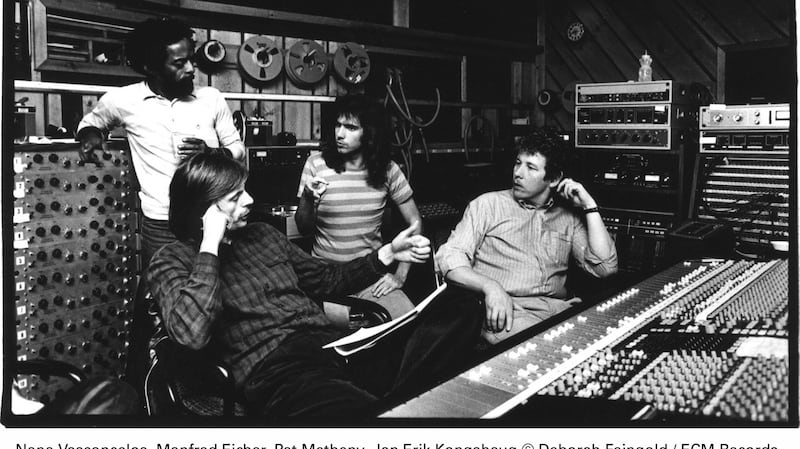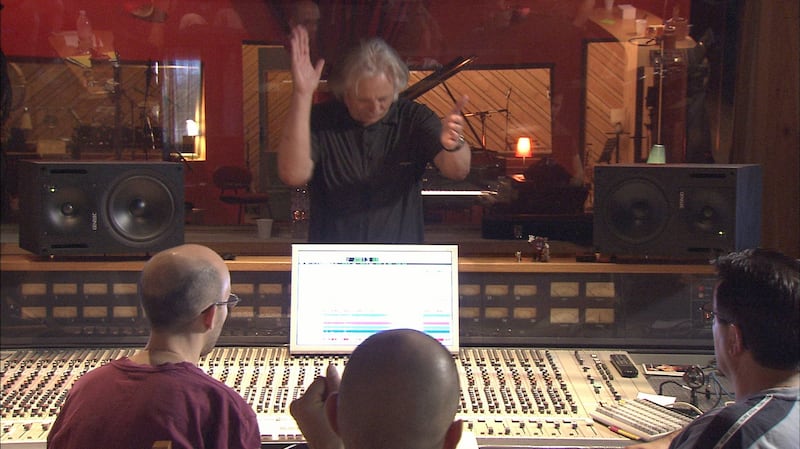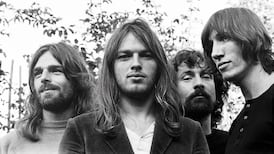Manfred Eicher is leaning over a mixing desk, lost in concentration. Dressed in his trademark grey, white shoulder-length hair hanging down over perhaps the most influential ears in contemporary jazz, the producer is as instantly recognisable as one of his ECM label's enigmatic album covers.
Through the window in front of him the Hungarian guitarist Zsofia Boros sits in the studio's performance space, surrounded by a forest of microphones, reeling off takes of an exquisite Argentinian folk tune. As he listens Eicher conducts the music to himself, feeling the ebb and flow of the tempo, nodding approvingly at phrasing he likes and sharing occasional comments with Stefano Amerio, his engineer, at the RSI Svizzera studio in the Swiss city of Lugano. The two communicate in a shorthand they have developed over many sessions together. They pore over details such as the position of the microphones, the tuning of Boros's instrument or where one track is placed in relation to the next, but once a decision has been made Eicher moves swiftly on, focusing almost exclusively on the performance. This can't be the irascible autocrat of the studio I have been led to expect.
When he turns around to chat the Bavarian-born producer is all affability. How was my journey? How is the weather in Ireland? He doesn’t ask what I think of the music but seems pleased when I venture a positive opinion. Yes, he murmurs, it’s very beautiful.


After four takes Boros comes into the control room, stress etched on her face. As they listen back Eicher lightens the mood, dancing his artist around the room to signal his approval of her phrasing. “There are little details that make sometimes a huge difference,” he says later. “It’s not a question of technical things. That also is part of it, but it’s important for me as a producer how to talk to a musician while recording, what to articulate more or less in front of the microphones. I will be their first listener, and for me it’s important how someone is phrasing, how they are creating their sound, the colours, the suspension. You can guide the music to a certain degree, or you cannot guide it . . . but you have to pay close attention to the sound that comes out.”
The ECM sound
The “ECM sound” is a term that crops up regularly in reviews of the Munich label’s recordings. The sound of the room, the position of the microphones, the selection of the material and, above all, the quality of the musician are all considered carefully, but as the selected takes are mixed Amerio points out with the pride of a craftsman that there is no artificial reverb, no EQ, no compression: just the pure sound of a guitar in an acoustic space.
Does Eicher get frustrated with the endless references to the ECM sound? “I’m not getting frustrated. I just think it’s kind of superficial. If people think that we ask musicians to record for us because we want to sculpt their sound in a certain kind of way, that’s nonsense. We chose musicians for their music.”
"We" is to overstate the matter somewhat. Since its inception, in 1969, Edition of Contemporary Music has exclusively reflected the taste of its founder. By then independent jazz labels were becoming a thing of the past, and the great American imprints, such as Blue Note and Impulse, were being swallowed up by conglomerates. But through its nearly five decades ECM has remained independent and uncommercial. A few of its releases have made handsome profits – notably the pianist Keith Jarrett's celebrated Köln Concert and Jan Garbarek's crossover hit, Officium – but commercial success has never been Eicher's yardstick, and he uses the high-profile releases to fund less commercial projects.
Thus has the ECM catalogue, which now numbers more than 1,000 titles, become perhaps the single most important repository of contemporary jazz on either side of the Atlantic.
“History is a big word,” says Eicher, with only a trace of modesty. “But it’s true, we have a lot of records in our catalogue that became history, because they set a certain direction before a trend was set. From the very beginning I was paying a lot of attention not only to what musicians I will record but how it will be recorded. I didn’t want it to sound like Blue Note or Impulse. I wanted to be more specific on chamber musical details, because that’s what I learned. I was a recording assistant for Deutsche Grammophon before I started ECM, so I wanted to record things a little different. I was lucky to find good engineers from the very beginning, who I trusted and who trusted me.”
He mentions Chick Corea's Return to Forever, Paul Bley's trio with Gary Peacock and Paul Motian, and Garbarek's Afric Pepperbird group as early critical successes. Many regard the Munich label as a bastion of European jazz, but ECM has also been a haven for creative American musicians who struggled to find recording opportunities in their own country. "For me music is music, and I get it wherever I like . . . I have actually recorded all the important Americans after the 1960s, after this first October Revolution in New York. I mean, except for Ornette [Coleman] and Miles [Davis], most of the important American musicians recorded with ECM."
Long-standing collaborations
Eicher clearly knows the value of his work. If there is a secret to his success, perhaps it is his ability to read his musicians' strengths and guide them accordingly. Frequently what have started as one-off recording projects have evolved into long-standing collaborations. "Well, I'm definitely someone who can be also a catalyst . . . Who would have thought that the Belonging group, with Keith Jarrett and Jan Garbarek, would be so successful? These things you can never foresee exactly. You can only guess; you can try. So I try."
Eicher deserves his place alongside the great producers of jazz's golden age – men such as Alfred Lion at Blue Note, Bob Thiele at Impulse and Teo Macero at Columbia. But in the 21st century Eicher stands virtually alone, the last great auteur producer, still creating, still nurturing new alliances and, crucially, still in control of his label's destiny.
He regards the contemporary music business with some mistrust. He’s not a fan of downloads and abhors the way albums can be filleted and reduced to playlists in defiance of an artist’s intentions. Is there just too much music in the world?
“There is not only too much music in the world, there is too much information on everything. There are so many books, so many pictures, so much everything, and the music needs to be selected in a better way. I’m not praising the old times only, but in the old days there were more producers who really understood what it means to listen, and to understand and analyse. Today there’s so many marketing people around who make decisions about what kind of music comes into the world. This is also a quality,” he adds. “I’m not diminishing that, but it’s not a criteria how to select good music”
As a long day’s recording ends he is visibly tired – most ECM albums are recorded and mixed in three intense days like this.At 72, Eicher might be forgiven for resting on his laurels, but his work ethic is still strong, and he gently bats away the suggestion that he might retire. “I’m still driven by the music, and I love music. Yes, it’s very stressful. This week I had different recordings in different places, and the circumstances of flying and travel are very difficult, but I really want to do what I’m doing. My life is music. That’s my home. And,” he adds with a rye smile, “my hearing is still in good shape.”
Label of love: A history of ECM in 10 albums, from Keith Jarrett to June Tabor
Keith Jarrett: Facing You (1971) The US pianist's first solo album is an astonishing outpouring of spontaneous melody. It was the beginning of a recording relationship that now extends to more than 80 recordings.
Keith Jarrett, Jan Garbarek, Palle Danielsson and Jon Christensen: Belonging (1974) The first meeting of Jarrett's "European" quartet exemplifies Eicher's instinct for collaborations. For many (including this writer), Belonging is one of the most joyously perfect recordings in the ECM catalogue.
Steve Reich: Music for 18 Musicians (1978) A seminal work of minimalism and a harbinger of Eicher's move towards contemporary composed music with his New Series.
Dave Holland: Seeds of Time (1982) One of several ground- breaking recordings by the English bassist that helped to introduce odd metres to jazz and other musicians to the influential saxophonist Steve Coleman.
Arvo Pärt: Tabula Rasa (1984) The first release of ECM's now similarly influential classical imprint, New Series; Eicher heard the Estonian composer's minimalist masterpiece by chance on his car radio and decided that he wanted to record it.
Kenny Wheeler: Music for Large and Small Ensembles (1990) The Canadian trumpeter and composer's masterpiece, a sonorous congregation of transatlantic talent that has become the new testament for big-band arrangers.
Jan Garbarek & the Hilliard Ensemble: Officium (1994) The Norwegian saxophonist Jan Garbarek remains Eicher's most promiscuous artist; this collaboration with an early-music vocal quartet was a huge if unlikely hit.
Nils Petter Molvaer: Khmer (1997) The first steps of what some call "future jazz", with Molvaer's trumpet soaring over beds of electronic noise and techno beats.
Tim Berne: Snakeoil (2012) Lion of the current New York scene, the saxophonist is just the latest in a line of American adventurers to find a haven at ECM.
June Tabor, Iain Ballamy and Huw Warren: Quercus (2013) The heartfelt folk singing of the renowned June Tabor extends into new territories with two of London's finest jazz musicians.
The ECM Series is at Triskel, Cork, tonight and Sunday; triskelartscentre.ie



















